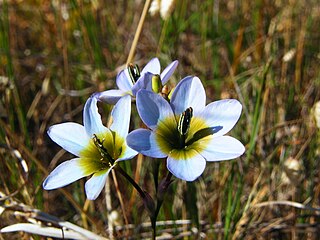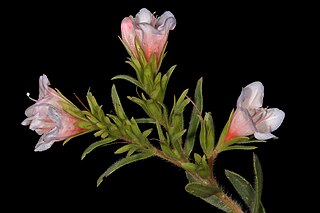
Agapanthus africanus, or the African lily, is a flowering plant from the genus Agapanthus found only on rocky sandstone slopes of the winter rainfall fynbos from the Cape Peninsula to Swellendam. It is also known as the lily-of-the-Nile in spite of only occurring in South Africa.

Disa is a genus of flowering plants in the family Orchidaceae. It comprises about 182 species. Most of the species are indigenous to tropical and southern Africa, with a few more in the Arabian Peninsula, Madagascar, and Réunion. Disa bracteata is naturalised in Western Australia, where the local name is "African weed-orchid."

Babiana is a genus of geophytes in the family Iridaceae with 93 recognized species as of March 2022. The leaves consist of a stalk and a blade that are at an angle to each other. The leaf blades are entire, laterally flattened and pleated, and often hairy. Each individual flower is subtended by two hairy or smooth bracts that are green in most species. The outer bract is often the largest of the two. In most species the bracts have a dry, brown tip, but in a few species it is entirely green or entirely dry when flowering or the outer bract is translucent and has a papery texture. The inner bract is forked or split all the way to its base. Each flower is without a pedicel, with six tepals that are merged at their base into a tube and form a perianth that is mirror-symmetrical in most species, with three anthers implanted where the perianth tube widens and that are, in almost every species, clustered at one side of the style. The style has three branches that widen towards the tip and the ovary is inferior. Flowers occur in almost every conceivable colour, many have markings on some of the tepals, and few star-symmetrical flowers have a centre that strongly contrasts with the free part of the perianth. The majority of these species are endemic to the west and southwest of South Africa, and southwestern Namibia, but one species occurs elsewhere in Namibia and South Africa and another species can be found in Botswana, Namibia, South Africa, Zambia and Zimbabwe. The genus name is derived from the Dutch word baviaan, referring to the Chacma baboon, Papio ursinus, that consumes the corms of plants in the genus. The genus is called bobbejaantjie in Afrikaans, meaning small baboon.

Disa bracteata, also known as the bract disa, leek orchid or the South African weed orchid is a species of orchid native to South Africa.

Moraea aristata is a species of flowering plant in the family Iridaceae. It is referred to by the common names blue-eyed uintjie or Blouooguintjie in Afrikaans.It is endemic to the city of Cape Town and is considered to be critically endangered.

Mimetes fimbriifolius, also called cowl pagoda or the fringed pagoda, is a species of plant in the family Proteaceae. It is a dense, rounded, multi-branched tree that grows up to 4 metres in height. This attractive and striking plant flowers all year round, and produces red and yellow branch-heads and inflorescences. The nectar-rich flowers are pollinated by sunbirds and the seeds are distributed and taken underground by ants before germinating. It is endemic to the Table Mountain range in the city of Cape Town, South Africa.

Ixia monadelpha, also known as the pied kalossie or bontkalossie, is an endangered species of geophyte found in wet sandy flats in the southwestern Cape of South Africa.

Disa ferruginea is a sturdy, reed-like terrestrial plant that typically grows between 200 and 450 mm tall. It has linear radical leaves that develop after flowering, while the dry cauline leaves form sheaths. The inflorescence is dense, with 1 to 40 flowers. The flowers themselves are bright red to orange, often with some yellow components. The median sepal has an apiculate tip, and a galea is 8 to 10 mm deep. The slender spur of the flower grades into the galea and measures 7 to 20 mm long. The lateral sepals project outward and are elliptic to narrowly elliptic, with apiculi that can reach up to 4 mm in length. The petals are spear-shaped and 5 to 7 mm long, while the lip is narrowly egg- to spear-shaped and 10 to 12 mm long.

Felicia tenella is an annual, sometimes biennial, herbaceous plant that may be slightly woody at its base, of 5–70 cm tall, that is assigned to the family Asteraceae. The species is very variable in size and hairiness. Its branches may be erect or ascending, and the leaves are narrowly line-shaped, 2–5 cm long and about 1 mm (0.04 in) wide. The leaves have a callous tip, lack visible nerves, and are mostly rigidly ciliate. The flower heads sit individually at the tip of stalks, have an involucre of three whorls of bracts, and about thirty light blue ray florets surrounding many yellow disc florets. Four subspecies are recognised. The species naturally occurs in the Northern Cape and Western Cape provinces of South Africa.

Lobostemon montanus, the turquoise bush bugloss, mountain lobostemon or agtdaegeneesbos, is a South African species belonging to the forget-me-not family.
Lobostemon daltonii, the Infanta healthbush, is a species of the forget-me-not family endemic to the Cape Provinces of South Africa.
Lobostemon decorus, the Rooiberg healthbush, is a species belonging to the forget-me-not family. It is endemic to the Western Cape of South Africa.
Lobostemon echioides, the common healthbush, is the mostly widely distributed species in its genus. It is endemic to the Cape Provinces of South Africa, where it is found growing between Namaqualand and the Karoo and the Eastern Cape.

Lobostemon fruticosus, also known as the eightday healthbush or pyjamabush, is a species of medicinal plant endemic to the Cape Provinces of South Africa. It is considered to be ecologically and economically important but is declining due to overexploitation.
Lobostemon glaber, the renoster healthbush, is a species of plant from South Africa. It is in the forget-me not family.

Babiana vanzijliae is a species of geophyte of 4–12 cm (1.6–4.7 in) high that is assigned to the family Iridaceae. It has leaves that consist of a sheath and a blade that are at an angle with each other. The leaf blades are narrow, sword- to lance-shaped and have a left and right surface, rather than an upper and lower surface. The leaf blades are pleated and covered in velvety hairs. The inflorescence contains three to five pale bluish mauve to yellow flowers, but the lower lateral tepals are yellow becoming pale around the edges, and with three stamens crowding under the upper lip. Flowering occurs from early August to the middle of September. The flowers emit a strong scent. B. vanzijliae grows along the Bokkeveld Escarpment near Nieuwoudtville in the Northern Cape province of South Africa.

Babiana sambucina is a species of geophyte of 8–30 cm (3.1–11.8 in) high that is assigned to the family Iridaceae. It has dense spikes of blue to violet-coloured, often fragrant flowers. There are two subspecies, B. sambucina subsp. longibracteata is restricted to a small area in the Northern Cape, B. sambucina subsp. sambucina grows in the Western Cape and Eastern Cape provinces of South Africa. Flowers are present in August and September.

Babiana mucronata is a perennial plant species that grows to about 5–18 cm (2.0–7.1 in) high and annually forms leaves and flowers from an underground corm. It is assigned to the iris family. It has a simple or branched, more or less upright spike of 3-12 dark to pale violet-blue, mirror-symmetrical flowers. Each flower consists of a perianth that is merged below into a funnel-shaped tube of 10–25 mm (0.39–0.98 in) long but splits into six unequal tepals. Three stamens are curved, crowded near the upper lip, and carry pale violet anthers. Flowers may be found between late July and September.
Manulea schaeferi is a species of plant from southern Africa. It grows in southern Namibia and the north-western parts of South Africa.

Heliophila africana, the African sunspurge or little blue mouth, is a species of plant from South Africa.














